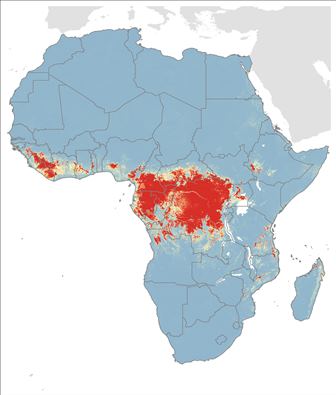Regions most at risk of Ebola mapped
9 September 2014
An international team of researchers has mapped the regions in Africa most at risk of an Ebola outbreak based on animal infections. The team has used data including the current Ebola outbreak, along with previously unmapped infections in bats, primates, and other animals, to provide a clear and up-to-date map of areas at risk of seeing transmission from infected animals to humans.
Previous work has shown that the first patient in an Ebola outbreak likely becomes infected through contact with an infected animal. In this study, the group reports that the regions likely to be home to animals harbouring the disease are more widespread than previously thought, particularly in West Africa. The current study does not encompass human-to-human transmission, which influences how the disease might spread further within the human population.

Areas where Ebola virus infection in animals is
likely
(colour scale ranging from red for most likely,
through yellow to blue for least likely).
The borders of all
African countries are outlined in grey.
Image Credit: Pigott et al. CC-BY 4.0
“Although the disease may be found in animals across a wide area, outbreaks are still very rare; very few animals in this region have detectable infections, and it is extremely rare for humans to catch the disease from them,” said David Pigott, one of the lead authors of the study. “Gaining a better understanding of where people are coming into contact with these infected animals, for example through hunting, and how to protect those at risk from Ebola is crucial to preventing future outbreaks.”
In order to find areas most at risk, the team identified the predicted distribution of bat species suspected to carry the disease. They also mapped a number of environmental factors — indicating the environmental suitability for the transmission of the disease from these host animals to humans. These data were combined with detailed data on locations where humans have been infected by wild animals and where infected animals have been identified. The resulting map indicates areas where new outbreaks might start in the future.
Next, the authors used population density maps of African regions to estimate the number of individuals living in at-risk areas, before going on to discuss population changes in those areas. With this work the team hopes to improve how we identify the risk of future outbreaks and their likely impact upon the resident human population.
Finally, the team suggests that their next priority will be to map the spread of the disease in past and present outbreaks in order to identify the most likely direction for the current outbreak. Such understanding would help to target surveillance efforts as well as education and medical interventions.
“This work was a first step towards understanding where outbreaks of the disease might occur in the future,” said author Nick Golding. “To prepare for future outbreaks and to deal with the current one we need to understand how human movements cause the disease to spread once it has entered the human population.”
Reference
Pigott DM, et al. Mapping the zoonotic niche of Ebola virus disease in Africa. Elife. Available online at http://dx.doi.org/10.7554/eLife.04395